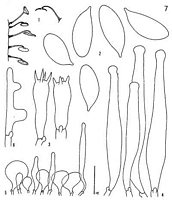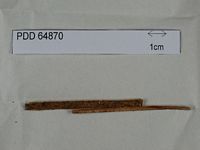|
 Anastrophella macrospora Anastrophella macrospora
BiostatusPresent in region - Indigenous. Endemic
Images (click to enlarge)
Caption: Anastrophella macrospora Horak & Desjardin (PDD, holotype): 1, basidiomes (x 3);
2, basidiospores (x 2000); 3, basidia (x
1000); 4, hymenial cystidia (x 1000);
5, pileipellis with pilocystidia (x 500);
6, terminal cell of cortical hy | 
Caption: Dried type specimen
Owner: Herb PDD |
Article: Horak, E.; Desjardin, D.E. (1994). Reduced marasmioid and mycenoid agarics from Australasia. Australian Systematic Botany 7: 153-170.
Description: Pileus to 3 mm diam., convex to inverted
saucer-shaped, nutant, hymenium rarely exposed upwards, convex, white, pruinose
to minutely setose, dry. Lamellae none, hymenophore smooth, white. Pseudostipe
up to 6 X up to 0.4 mm, central, inserted and gradually confluent into apex
(centre) of pileus, cylindrical or slightly enlarged towards apex, whitish to
glassy-hyaline, rather fragile, minutely pruinose overall, at base minutely
strigose-hairy, insititious (basal disc or byssus absent), dry, solid, solitary
in groups. Odour absent. Basidiospores 14-19 X 6.5-7.5 µm, elliptic to subfusiform,
inequilateral in profile, smooth, hyaline, inamyloid. Basidia 30-40 X 11-13
µm, tetrasporic, cylindric to subclavate, sterimata up to 10 µm long, clamped.
Hymenial cystidia scattered, 60-120 X 10-15 µm, slender fusiform with subglobose
apex (6-10 µm diam.), thin-walled, hyaline, often filled with strongly refringent
cell sap. Pileipellis hymeniform, composed of clavate or vesiculose cells 15-45
X 18-32 µm, non-gelatinous, thin-walled, hyaline. Pilocystidia scattered, 35-100
X 5-12 µm, subcylindric to slender fusiform, apex rounded or slightly swollen,
thin-walled, hyaline. Oleiferous hyphae absent. Stipe tissue monomitic. Stipe
cortical hyphae (4-8 µm diam., cylindric, parallel, thin walled, hyaline. Caulocystidia
inconspicuous, rarely differentiated, 6-50 X 6-11 µm, mostly as blunt and broad
projections, thin-walled, hyaline, clamped.
Habitat: On rotting leaves of Phormium tenax
J.R. & G. Forst. (Phormiaceae). Known from South Island of New Zealand.
Commentary
Notes: The new genus Anastrophella is characterised by nutant basidiomes with inverted-cupulate pilei and smooth hymenophore, a relatively long, central pseudostipe, and a hymeniform pileipellis of smooth, vesiculose cells and pilocystidia. It is allied with the genera Gloiocephala Massee (1892) and Physalacria Peck (1882). In essence, Anastrophella is a Gloiocephala with an upside down pileus and correspondingly nutant habit.
Singer (1976: 311) erected the monotypic taxon Physalacria sect. Pileolina Singer for P. subpeltata Redhead [a binomial that wasn't published validly until 1979 (Redhead 1979)], separating the species from Physalacria s. str. (Berthier 1985) because of the discoid-pileate, pseudostipitate basidiomes. Subsequently, Singer (1986: 374) transferred Physalacria sect. Pileolina and Gloiocephala sect. Sessiles Singer (1976) to the genus Deigloria Agerer (1980), thereby restricting Physalacria to those species with stalked-capitate basidiomes, i.e. with a globose to obclavate, hollow pileus that is fertile over the entire external surface and sits atop a short pseudostipe. We concur with Agerer (1980) that Ph. subpeltata is distinct from Deigloria, differing in forming a well-developed pseudostipe, a discoid-nutant pileus, a pileipellis composed of clavate to vesiculose cells lacking apical appendages and with fusiform-subcapitate pilocystidia and capitate gloeocystidia. In contrast, Deigloria is characterised by sessile-cupulate basidiomes, a non-fertile surface composed of mucronate or broom-like elements, and dermatogloeocystidia with an apical whorl of finger-like appendages (Agerer 1980).
We agree with Singer (1986) that the species he placed previously in Gloiocephala sect. Sessiles rightfully belong in Deigloria, but we consider his sect. Pileolina as distinct from both Physalacria and Deigloria. Accordingly we propose the new genus Anastrophella to accommodate Ph. subpeltata and the New Zealand specimen. For further discussion about taxonomic relationships, cf. Hispidocalyptella.
|